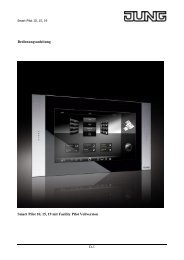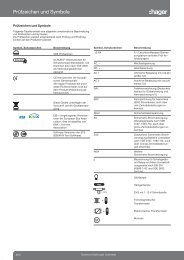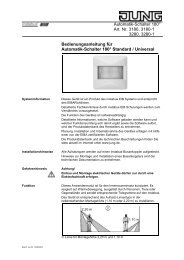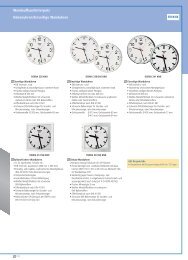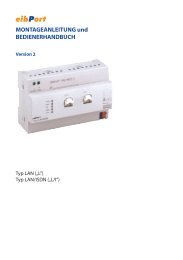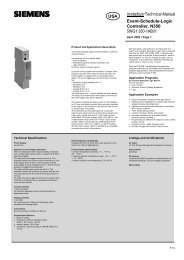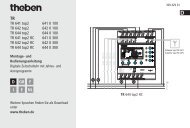Create successful ePaper yourself
Turn your PDF publications into a flip-book with our unique Google optimized e-Paper software.
i External switching units are components such as keyswitches, transponder units, code<br />
keypads or block locks. In many cases, such units are intended for use in alarm or signalling<br />
systems and, for this reason, can monitor for sabotage. Simple installation buttons<br />
or KNX/EIB button sensors can easily be used as switching units. However, these do not<br />
provide any protection against unauthorised sabotage access. For this reason, button<br />
sensors are often attached within a building to be protected, for example to activate the external<br />
skin monitoring ("internal arming").<br />
External switching units can be coupled to the panel's signalling system using separate<br />
1 bit objects. The sabotage contacts of the switching unit can be included using the "Sabotage"<br />
detector input (see chapter 4.2.4.12.2. Detector).<br />
The signalling system makes a distinction between security areas, the interior and the external<br />
skin. This distinction allows separate monitoring and arming of different building sections depending<br />
on whether authorised people are in them or not. During the project planning of the signalling<br />
system in the ETS plug-in, created detectors are assigned to the security areas.<br />
"External skin" security area:<br />
The external skin separates the interior area of a object to be secured, from the external area.<br />
Detectors integrated in the external skin can, for example, detect unauthorised access or sabotage<br />
to the house or garden door, to the building windows and to the garage door. In these<br />
cases, suitable detectors are often magnetic contacts or glass break sensors.<br />
The external skin can be armed separately. Arming usually take place using a switching unit,<br />
located within the building (e.g. button on the panel, button sensor). In this case, there are authorised<br />
people in the building. Only monitoring of the external skin takes place. Only the internal<br />
siren is activated when there is an alarm. This status is called "internally armed".<br />
Order-No. 7574 00 1X<br />
picture 36: External skin as signalling area - "internally armed"<br />
Software "...590101"<br />
Functional description<br />
"Interior" security area:<br />
Detectors are assigned to the interior of a building to be secured which can protect the interior<br />
area, i.e. the lived in spacers of a building, against break-ins and sabotage. Suitable detectors<br />
would be magnetic contacts on internal doors or motion detectors on walls or ceilings.<br />
The interior is always armed and monitored together with the external skin. Arming often take<br />
place using a switching unit, for example located on the outside, next to the entrance door.<br />
However, this switching unit can be located within a building (e.g. button on the panel, button<br />
sensor) and can arm the security areas in conjunction with an arming delay (see chapter<br />
4.2.4.12.3. Arming). When armed, no authorised people are in the building. There is then external<br />
skin and interior monitoring. The internal siren and the visual alarm are activated when<br />
there is an alarm. This status is called "externally armed".<br />
Page 111 of 222




